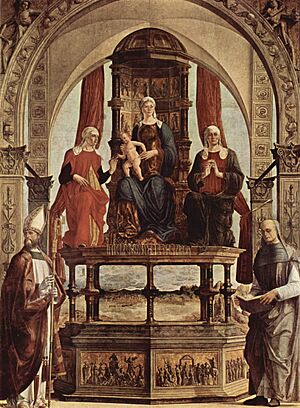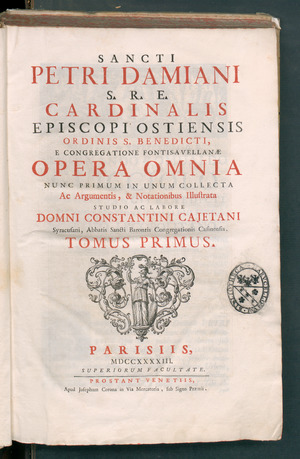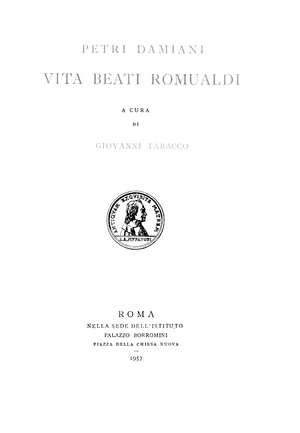Peter Damian facts for kids
Quick facts for kids SaintPeter Damian |
|
|---|---|

Bust of Peter Damian. Found in Santa Maria degli Angeli, Florence.
|
|
| Bishop, Confessor and Doctor of the Church | |
| Born | c. 988 Ravenna |
| Died | 22 February 1072 or 1073 Faenza |
| Venerated in | Roman Catholic Church |
| Feast | 21 February earlier 23 February (General Roman Calendar, 1823-1969) |
| Attributes | represented as a cardinal bearing a knotted rope in his hand; also as a pilgrim holding a papal Bull; Cardinal's hat, Benedictine monk's habit |
Peter Damian (born around 1007 – died February 21 or 22, 1072 or 1073) was an important Benedictine monk and cardinal. He worked to reform the Church during his time. The famous writer Dante even mentioned him in his book Paradiso. Peter Damian was later declared a Doctor of the Church in 1828. His special day, called a feast day, is celebrated on February 21.
Contents
Peter Damian's Early Life
Peter was born in Ravenna, Italy, around the year 988. He was the youngest child in a large, noble family that was not very rich. Sadly, he became an orphan early in life. An older brother took him in but treated him badly, making him work as a swineherd (someone who looks after pigs) and not giving him enough food.
After some years, another brother named Damianus, who was a church leader in Ravenna, felt sorry for Peter. He took Peter away and made sure he got an education. Peter added his brother's name to his own. He studied theology (the study of religious faith) and church law very quickly. He studied first in Ravenna, then in Faenza, and finally at the University of Parma. By the time he was about 25, he was already a well-known teacher in Parma and Ravenna.
Becoming a Monk
Around 1035, Peter decided to leave his teaching job. He chose to join a quiet hermitage (a place where monks live alone or in small groups) called Fonte Avellana, near Gubbio. He avoided the richer, more comfortable monasteries of the time.
As a new monk, Peter was very dedicated. He practiced extreme forms of self-discipline, like doing penance (punishing himself for sins). This was so intense that it affected his health and he had trouble sleeping. After he got better, he was asked to teach the other monks. He also taught monks from nearby monasteries for a few years. Around 1042, he wrote a book about the life of St Romuald.
Soon after returning to Fonte Avellana, he became the manager of the monastery. In 1043, he became the prior (the head) of Fonte Avellana. He stayed in this role until he died in February 1072.
Under Peter's leadership, the monastery became very famous. He started new hermitages in other places like San Severino and Sitria. He was very passionate about making monastic life stricter and better. He introduced a practice called disciplina, which involved flagellation (light self-whipping) as a form of penance. This practice became very popular, even in big monasteries like Monte Cassino. However, Peter later had to tell some of his own monks to be less extreme in their self-discipline.
Peter also introduced a daily siesta (a short nap) to help monks recover from their night prayers. During his time as prior, a cloister (a covered walkway) was built, and the monastery bought silver chalices (cups for religious ceremonies) and a silver processional cross. Many books were also added to the library.
Working for Church Reform
Even though he lived a quiet life in the monastery, Peter Damian cared deeply about the Church. Like his friend Hildebrand (who later became Pope Gregory VII), he worked hard to fix problems during a difficult time. The Church had faced many political and social changes, and there was a lot of ignorance and corruption among the clergy (church leaders).
When Pope Benedict IX left his position in 1045, Peter was very happy. He wrote to the new pope, Pope Gregory VI, asking him to deal with the scandals in the Italian Church, especially mentioning bad bishops in places like Pesaro and Fano.
Peter also started communicating with the Emperor Henry III. He was in Rome when Pope Clement II crowned Henry III and his wife. He also attended a meeting called a synod in 1047, where rules were made against simony (the buying or selling of church positions). After this, he went back to his hermitage.
His Ideas on Philosophy
Peter Damian often spoke against philosophy. He believed that monks did not need to study philosophy to be saved, because Jesus did not choose philosophers as his followers. However, he also had an important idea: that philosophy should serve theology (the study of God and religious belief), like a servant helps her mistress. This idea was later used by other thinkers like Thomas Aquinas.
Peter's writings on God's power, especially in his work De divina omnipotentia, are often discussed. He wanted to show that God can do anything that is good, for example, God cannot lie. He also understood that God can act outside of time.
Becoming a Papal Envoy and Cardinal
While Peter was ill, the pope died. Frédéric, the head of Monte Cassino monastery, was chosen as the new pope, Stephen IX. In 1057, Pope Stephen IX wanted to make Peter Damian a cardinal. Peter did not want this job at first. He preferred being a traveling preacher and hermit rather than a reformer working inside the Church's main office (the Curia). But he was finally convinced and became the Cardinal Bishop of Ostia on November 30, 1057. He also became the administrator of the Diocese of Gubbio.
Peter felt the great responsibility of his new role. He wrote a strong letter to the other cardinals, telling them to be good examples for everyone. Four months later, Pope Stephen died, and the Church faced another schism (a split). Peter strongly opposed the antipope Antipope Benedict X, but the intruder had more power. So, Peter went back to Fonte Avellana for a while.
Working in Milan
Around late 1059, Peter was sent to Milan by Pope Nicholas II. Things were very bad in Milan: church positions were openly bought and sold, and clergy members were publicly married. The Milanese clergy resisted reforms, leading to a big fight. So, they asked the Holy See (the Pope's authority) for help.
Pope Nicholas II sent Peter Damian and the Bishop of Lucca to Milan. The clergy who were against reform became worried. They claimed that Rome had no power over Milan. Peter bravely faced the angry crowd in the cathedral. He showed them how important the Holy See's authority was. Everyone eventually agreed to his decisions.
First, he made the archbishop and all the clergy promise that no church position would be bought in the future. Then, he gave a penance to those who had been guilty and allowed those who promised to live in celibacy (not marrying) to keep their positions. Some strict people in Rome criticized this decision, but it was not changed.
Sadly, when Pope Nicholas II died, the same problems started again in Milan. They were not fully solved until 1066. Meanwhile, Peter kept asking to be released from his duties, but neither Pope Nicholas II nor Hildebrand would let him go.
Later Years and Missions
Peter Damian helped Pope Alexander II in his fight against the antipope, Antipope Honorius II. In July 1061, Pope Nicholas II died, and another split happened in the Church. Peter Damian tried his best to convince the antipope Cadalous to step down, but it did not work. Finally, a council was held in Augsburg, Germany. A long argument written by Peter Damian was read there, which greatly helped the decision to support Alexander II.
In 1063, the pope held a meeting in Rome. Peter Damian was sent to France to solve a disagreement between the Abbey of Cluny and the Bishop of Mâcon. He went to France, called a council, proved that Cluny's claims were fair, and settled other Church issues in France. He returned to Fonte Avellana in the autumn.
While he was in France, the antipope Cadalous tried again to take control of Rome. Peter Damian was criticized by Alexander and Hildebrand for asking the royal power to judge the case again. In 1067, Peter was sent to Florence to solve a dispute between the bishop and the monks of Vallombrosa. The monks accused the bishop of simony. His efforts were not successful because he misunderstood the situation and supported the bishop. The pope himself had to settle the matter the next year.
After serving the papacy as a special representative in France and Florence, he was allowed to leave his bishop position in 1067. After some time back at Fonte Avellana, he went to Germany in 1069 as a papal representative. He convinced Emperor Henry IV to give up his plan to divorce his wife Bertha. He completed this task at a council in Frankfurt before returning to Fonte Avellana.
In early 1072 or 1073, he was sent to Ravenna to help its people make peace with the Holy See. They had been excommunicated (kicked out of the Church) for supporting their archbishop, who sided with the schism of Cadalous. On his way back, he became sick with a fever near Faenza. He was ill for a week at the monastery of Santa Maria degl'Angeli. On the night before a special feast day, he asked for the prayers of the feast to be recited. He died at the end of the morning prayers. He was buried right away in the monastery church so that others would not try to claim his relics (holy remains).
In his final years, Peter Damian did not fully agree with the political ideas of Hildebrand. He died the year before Hildebrand became Pope Gregory VII. Some historians believe Peter's death removed the only person who could have kept Gregory in check.
Honoring Saint Peter Damian
Peter Damian is recognized as a saint. He was made a Doctor of the Church by Pope Leo XII in 1828. His feast day is now celebrated on February 21. Before 1970, it was on February 23.
His body has been moved six times. Since 1898, Peter Damian has rested in a chapel dedicated to him in the cathedral of Faenza. He was never formally made a saint through a special ceremony (canonization). However, people have honored him as a saint since his death in Faenza, Fonte Avellana, Monte Cassino, and Cluny.
In art, Saint Peter Damian is often shown as a cardinal holding a knotted rope (the disciplina). Sometimes, he is also shown as a pilgrim holding a papal Bull (an official paper from the Pope), which shows his many missions as a papal representative.
His Writings
Peter Damian wrote many things, including 67 treatises (long essays), letters, sermons, prayers, and hymns. His writings show the strong religious feelings in Italy at the time, which later led to the First Crusade.
Some of his important works include:
- His most famous work, De Divina Omnipotentia, is a long letter where he talks about God's power.
- In Dominus vobiscum, he discusses whether a hermit praying alone should use the plural "you" (as in "the Lord be with you all"). He decided the hermit should use the plural because he is connected to the whole Church.
- His Life of Romauld and The Eremitical Order show his belief that living alone and practicing strict self-discipline is the best way to live a Christian life.
- He was very devoted to the Virgin Mary and wrote an Officium Beatae Virginis (Office of the Blessed Virgin).
- De Institutione monialis aimed to protect Western Christians from what he saw as bad habits from the East. In this work, he criticized Maria Argyre for using a golden fork to eat, as forks were a new invention then.
- Disceptatio synodalis, which defended Pope Alexander II against Antipope Honorius II.
- Liber Gratissimus, which was against simony (buying or selling church positions).
See also
 In Spanish: Pedro Damián para niños
In Spanish: Pedro Damián para niños




